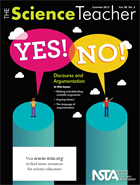Discourse and argumentation
By Mary Bigelow
Posted on 2013-07-13

“Let’s argue” writes the editor in his introduction to this issue. But he is referring to scientific argumentation–the goal of which is to “reach consensus in a collaborative search for truth.” The practice of arguing from evidence (along with the related practice of obtaining, evaluating, and communicating information) is identified as a scientific and engineering practice that is incorporated in the NGSS.
So what does argumentation look like in a real classroom? The featured articles in this issue have many ideas for refocusing our instruction by integrating this practice into science activities.
To show how scientists use this process, Argumentation in Science Education includes a summary of the claim, evidence, and justification in Watson and Crick’s work on the structure of DNA. The article also has a graphic showing the components of an argument and criteria that can be used to evaluate them. The authors note that the biggest challenge for students is in justifying their evidence. They illustrate this with student experiences in studying why some pendulums swing faster than others. Students will need opportunities and guidance to craft arguments successfully. [See SciLinks for more on science content related to Pendulums.]
Making and Defending Scientific Arguments describes four strategies for scaffolding students in the process of argumentation: making an inference from observations, agreeing or disagreeing with a statement (the author includes several starter sentences to guide students), testing another person’s claim, and making your own claim (with organizational lists for argument-based oral reports and lab reports). The author notes that argumentation is a “higher-level, critical-thinking skill.” But students at any grade level can participate in the process. [See this month’s Science & Children and Science Scope.]
I’m going to share a copy of Arguing History with a social studies colleague. The authors highlight several controversies in the history of science that students can investigate through a “case study”: an overview of the controversy, group investigations into the details, argumentation in which the groups defend a position, and resolution. The case study incorporates cooperative group methods and a historical perspective.
The author of The Language of Argumentation compares argumentation (a position based on evidence) and debate (a formal setting in which two teams present their arguments using a specific format). She describes an activity to introduce students to debating (a forum that most students have never seen or participated in). Based on the topic “Does the world need nuclear energy?” the article has examples of discussion questions, a writing prompt template, a peer observation form, and examples of the claims, data, and warrants for the students’ debate. [See SciLinks for more on science content related to Nuclear Energy, Nuclear Reactors.]
What’s the Alternative? has suggestions for helping students make the connections between evidences and alternative models. Using MEL diagrams (Model-Evidence Link) students can graphically see and evaluate the connections. The authors provide examples and templates used during an investigation of climate change. [See SciLinks for more on science content related to Climate Change.]
Another strategy to help students learn about and use the practice of argumentation is through role-playing activities. The authors of Hook, Line, and Sinker note that although these activities may take several class periods, they provide a context for students to learn about and understand core science content, such as (in this case of the population decline of bluefish tuna) species interdependence, life cycles, limiting factors, carrying capacity, population dynamics, and predation. By giving students a role to play and an audience, they make a more personal connection beyond definitions. The article has links to role cards, record sheets, discussion questions, and other materials. [See SciLinks for more on science content related to Ocean Fisheries.]
Disclaimer: The views expressed in this blog post are those of the author(s) and do not necessarily reflect the official position of the National Science Teaching Association (NSTA).


